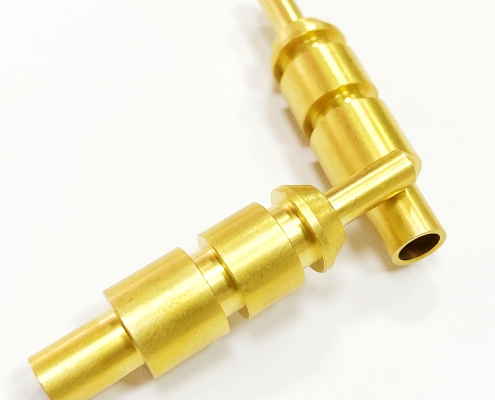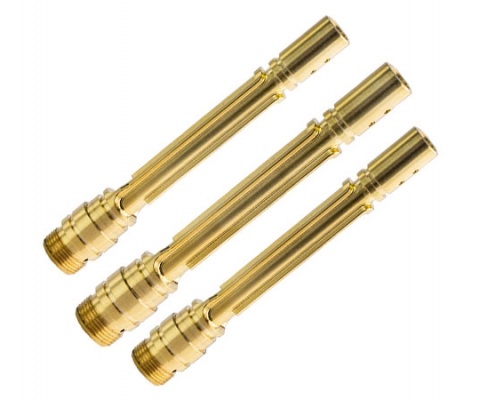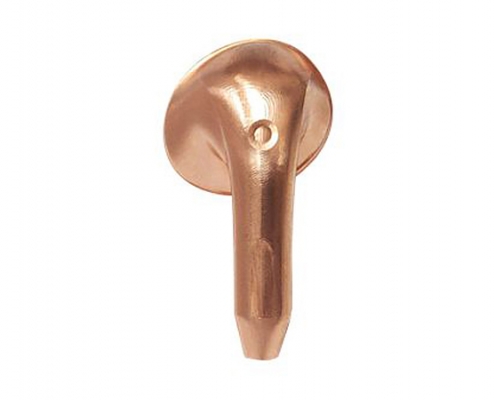Types of Brass: CNC Machining Materials Guide
Brass is a popular CNC machining material, but picking the wrong type can result in poor machinability or corrosion issues. Learn how to choose the right brass for your project.
What Is Brass?
Brass is an alloy of copper and zinc, which can also contain trace elements like lead, tin, or aluminum to enhance specific properties. The brass composition and percent composition of brass vary depending on the intended application, resulting in different grades of brass and brass material properties.
Brass is known for its golden color, which can resemble yellow bronze or red brass depending on the zinc content. The chemical formula of brass doesn’t exist in a fixed form due to its alloy nature, but it primarily consists of Cu and Zn.

Properties and Characteristics of Brass
Brass is a widely used material in CNC machining due to its excellent combination of mechanical and aesthetic properties. Its versatility stems from its alloy composition, which can be adjusted to meet various needs, such as strength, corrosion resistance, and machinability. Below is the brass’s key properties:
| Property | Description |
|---|---|
| Brass hardness | Varies by alloy; C360, a popular grade, has a hardness of around 80 Rockwell B. |
| Brass tensile strength | Typically ranges between 300-500 MPa, depending on the specific alloy. |
| Brass density | Approximately 8.4-8.7 g/cm³, making it a dense and durable material. |
| Brass temperature rating | Operates effectively at temperatures up to 200°C without significant degradation. |
| Brass bonding type | Features metallic bonding, which contributes to its ductility and malleability. |
How Many Types of Brass Are There?
Brass comes in many forms, often classified by composition, application, or machinability. The main types include:
C360 (Free-Cutting Brass)
C360 is the go-to choice for applications that require high precision and efficiency. Its small lead content significantly enhances its machinability, reducing tool wear and making it easier to achieve fine details. This brass is widely used in industries that produce intricate components such as watch gears, valve stems, and connectors.
C260 (Cartridge Brass)
C260, also known as Cartridge Brass, is highly ductile, allowing it to be drawn into thin sheets or wires without breaking. Its attractive golden color and excellent corrosion resistance make it a popular choice for decorative applications, musical instruments like trumpets, and even industrial uses such as ammunition casings.
C464 (Naval Brass)
C464 is specifically engineered for harsh environments, particularly marine settings. The added tin improves its resistance to saltwater corrosion, making it an excellent material for ship propellers, seawater pump shafts, and other marine hardware. It is also known for its strength and wear resistance.
C230 (Red Brass)
With a higher copper content (usually around 85%), C230 has a rich reddish appearance that is both aesthetically pleasing and functional. It resists tarnishing and corrosion, which makes it perfect for plumbing applications, ornamental decorations, and artistic sculptures. It also conducts electricity well, so it’s sometimes used in electrical connectors.
C353 (Leaded Brass)
C353 contains a high amount of lead, offering superior machinability, making it perfect for high-speed manufacturing processes. Its smooth finish and excellent durability make it ideal for products like faucet parts, fittings, and other components where precision and reliability are critical.
H59, H62 (Chinese Standards)
H59: This type of brass has a lower copper content, providing higher strength and making it suitable for manufacturing mechanical parts, fasteners, and general hardware. It’s an economical choice for many industrial and household products.
H62: With a slightly higher copper content, H62 offers better ductility, making it easier to form into complex shapes. It’s often used in electrical components, decorative items, and automotive parts due to its good balance of strength and flexibility.
Red Brass vs Yellow Brass
Red brass and yellow brass are two widely used types of brass, each offering unique benefits based on their composition. The key differences lie in their copper and zinc content, which influence their appearance, mechanical properties, and suitability for various applications. Understanding these differences can help in selecting the right material for CNC machining or other specific purposes.
| Aspect | Red Brass | Yellow Brass |
|---|---|---|
| Copper Content | Approximately 85% | Lower copper content, with 60-70% copper and 30-40% zinc |
| Zinc Content | Low zinc content (typically below 15%) | High zinc content (30-40%) |
| Appearance | Rich reddish hue | Bright, gold-like color |
| Corrosion Resistance | Excellent, ideal for moist or corrosive environments | Good, but less resistant compared to red brass |
| Ductility | High, making it easier to shape and form | Moderate, with slightly more rigidity than red brass |
| Conductivity | Excellent electrical and thermal conductivity | Lower conductivity due to higher zinc content |
| Strength | Softer, with moderate strength | Harder, providing better structural support |
| Applications | Plumbing fittings, decorative elements, electrical components | Hardware, automotive parts, musical instruments, and decorative items |
Choosing the Right Brass Alloy for CNC Projects
Selecting the right brass alloy depends on machinability, environmental needs, and application-specific factors:
1. Machinability
Alloys like C360 are ideal for precision machining due to their lead content, while lead-free options such as C693 are better for health-sensitive uses like drinking water systems.
2. Environmental Resistance
For marine environments, C464 Naval Brass resists saltwater corrosion, while C230 Red Brass is excellent for plumbing and moisture-prone applications.
3. Cost and Weight Considerations
When budget or weight matters, consider alternatives like aluminum for its lightness or zinc for cost-effectiveness. Brass remains unmatched in aesthetics, corrosion resistance, and conductivity for specific needs.

Comparison: Brass vs Aluminum vs Stainless Steel
Brass, aluminum, and stainless steel are three popular materials widely used in engineering, manufacturing, and CNC machining. Each material offers unique characteristics in terms of strength, corrosion resistance, machinability, and appearance. Below is a detailed comparison to help you understand their differences and choose the best material for your application.
| Aspect | Brass | Aluminum | Stainless Steel |
|---|---|---|---|
| Density | 8.4–8.7 g/cm³ | 2.7 g/cm³ | 7.7–8.0 g/cm³ |
| Strength | Moderate; tensile strength ~300–500 MPa | Lower; tensile strength ~70–300 MPa | High; tensile strength ~400–900 MPa |
| Corrosion Resistance | Excellent, especially in moist environments | Good; resistant to oxidation but can corrode in saltwater | Excellent, particularly with high-grade alloys |
| Machinability | Very good, especially with leaded grades | Excellent; lightweight and easy to machine | Moderate; harder to machine due to toughness |
| Weight | Heavy compared to aluminum | Lightweight | Heavy but comparable to brass |
| Appearance | Bright gold-like or reddish (depending on type) | Dull silver, can be anodized for color | Shiny, reflective silver, often polished |
| Thermal Conductivity | Excellent, ideal for heat exchange | Excellent, widely used in thermal applications | Moderate, good for high-temperature environments |
Applications of Brass in CNC Machining
Brass’s unique properties, such as machinability, corrosion resistance, and conductivity, make it an essential material for many industries. Here’s a closer look at its applications:
1. Aerospace
Brass is used in hydraulic components due to its durability, precision machinability, and resistance to wear. Its ability to withstand high pressures and maintain performance under varying conditions makes it ideal for critical aerospace systems.
2. Automotive
In the automotive sector, brass is commonly used for bushings, fuel nozzles, and other high-performance components. Its excellent wear resistance and ability to form tight seals ensure reliability and efficiency in demanding environments.
3. Electronics
Brass is a top choice for connectors, terminals, and pins due to its excellent electrical conductivity and resistance to corrosion. It is often used in high-performance electronics, ensuring stable and long-lasting connections.

4. Medical Devices
In the medical field, brass is used for surgical tools and connectors due to its biocompatibility, precision machinability, and ease of sterilization. It ensures high reliability and performance in critical applications.
VMT’s CNC Brass Machining Capabilities
At VMT, we have 8sets HAAS CNC machining centers, 20 sets CNC lathes, 66 sets of 3, 4, and 5 axes CNC machines, 30 sets CNC lathes, and 20 sets of automatic lathes. The precision is within 0.01mm. Contact us immediately for a free quote on CNC Machining brass parts!

In Conclusion
Brass offers machinability, strength, and resistance to corrosion that make it ideal for CNC machining across industries. Knowing the various types of brass, their composition of brass, and machining characteristics ensures the optimal selection for your manufacturing needs. Whether you need brass picture-perfect finishes or functional resistance in brass composed of copper and zinc, there’s a brass grade suited to every application.
Frequently Asked Questions About Brass
How Many Types of Brass Are There?
There are over 60 standard types of brass, generally categorized into two main groups: alpha brass (less than 37% zinc) and alpha-beta (duplex) brass (37–45% zinc). These types vary by alloying elements and intended applications.
What is the Best Grade of Brass?
C360 (Free-Cutting Brass) is considered one of the best grades due to its excellent machinability, strength, and corrosion resistance. It’s widely used in precision components and fittings.
What is the Strongest Brass?
High tensile brass, such as C48500, is among the strongest, offering excellent strength, toughness, and corrosion resistance. It’s commonly used in marine and industrial applications.
What is 60/40 Brass Called?
60/40 brass is commonly called Cartridge Brass or C260 Brass. It contains 60% copper and 40% zinc, offering a good balance of strength, ductility, and corrosion resistance.
How to Clean Brass?
Use a mixture of vinegar, salt, and flour to make a paste, apply it to the brass, let it sit, then rinse and polish. Commercial brass cleaners also work well for tougher tarnish.
Is Brass Magnetic?
No, brass is not magnetic. It’s a non-ferrous alloy of copper and zinc, so it won’t be attracted to magnets unless it contains trace amounts of iron.
Do Brass or Woodwinds Typically Have Lead?
Yes, some brass instruments and woodwinds may contain small amounts of lead in solder or fittings. Modern regulations limit lead content, and manufacturers often label lead-free options.



